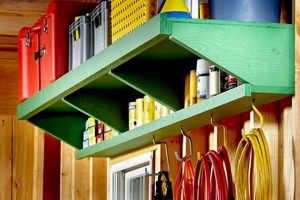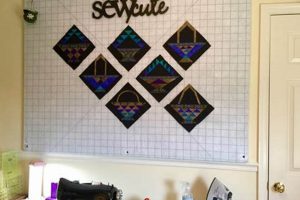Illumination fixtures that are mounted on walls and created through self-directed construction are the subject of this discussion. These lights, offering both ambient and task lighting, can be adapted to specific aesthetic preferences and functional needs through the application of individual skill and available materials. As an example, repurposing mason jars combined with electrical wiring to produce rustic-style lighting.
The increasing interest in handcrafted home decor drives the popularity of these personalized lighting solutions. This approach often results in cost savings compared to purchasing pre-made alternatives. Furthermore, engaging in the creation process allows for a high degree of customization, reflecting the unique style of the individual and the overall design of the interior space. Historically, sconces provided a primary light source before the widespread adoption of electric lighting.
This article will explore the various materials, techniques, and safety considerations involved in the successful fabrication of such personalized lighting options. It will further delve into design principles and practical guidance for achieving desired illumination effects and enhancing interior aesthetics.
Essential Guidance for Self-Constructed Wall Illumination
The following recommendations address crucial aspects of designing and implementing wall-mounted lighting solutions that are independently created. Careful attention to these points ensures both aesthetic appeal and functional safety.
Tip 1: Prioritize Electrical Safety. De-energize the circuit at the breaker before commencing any wiring. Utilize appropriate gauge wiring and secure connections to prevent hazards such as short circuits or electrical fires. Consult with a qualified electrician if uncertain about any aspect of the electrical work.
Tip 2: Select Appropriate Materials. Choose materials suitable for heat resistance and structural integrity. Metal components should be corrosion-resistant, and any wood utilized near heat sources should be properly treated. Consider the long-term durability and aesthetic compatibility of the chosen materials.
Tip 3: Plan the Mounting System. Securely anchor the fixture to the wall using appropriate hardware for the wall type (drywall, plaster, wood). Ensure the mounting system can support the weight of the sconce and any attached accessories. Improper mounting can lead to instability and potential damage.
Tip 4: Consider Light Source Options. Evaluate different bulb types (LED, incandescent, halogen) based on energy efficiency, light output (lumens), color temperature (Kelvin), and lifespan. LED bulbs generally offer the best combination of efficiency and longevity. Select bulbs appropriate for the intended ambiance and task lighting requirements.
Tip 5: Incorporate a Junction Box. Utilize a standard junction box for all wiring connections. This provides a safe enclosure for connections and protects against accidental contact. Ensure the junction box is properly grounded and accessible for future maintenance.
Tip 6: Ensure Proper Ventilation. Design the fixture to allow for adequate ventilation around the light bulb. Excessive heat buildup can shorten the lifespan of the bulb and pose a fire hazard. Consider incorporating ventilation holes or heat-dissipating materials in the design.
Tip 7: Apply a Durable Finish. Protect the finished fixture with a durable paint, sealant, or coating to prevent corrosion, wear, and damage. Select a finish that complements the overall aesthetic of the sconce and the surrounding dcor.
These guidelines emphasize the importance of safety, material selection, and careful planning in the creation of effective and visually appealing lighting. Adherence to these principles will contribute to a successful and enduring result.
The subsequent sections of this article will address advanced design considerations and explore innovative approaches to achieving unique and personalized lighting solutions.
1. Electrical Safety Protocols
Electrical safety protocols are paramount in the design and construction of self-assembled wall-mounted lighting. Deviations from established safety standards introduce significant risks, potentially leading to electric shock, fire hazards, and property damage. Strict adherence to these protocols is non-negotiable when undertaking such projects.
- Circuit Deactivation Prior to Wiring
Before any wiring work commences, deactivation of the relevant circuit at the electrical panel is mandatory. This measure prevents the flow of electricity to the work area, eliminating the risk of accidental electrocution. Failure to adhere to this protocol represents a critical safety violation.
- Correct Wire Gauge Selection
Employing the appropriate wire gauge for the intended electrical load is essential. Undersized wiring can overheat, leading to insulation damage, short circuits, and potential fires. Wiring gauge must be matched to the wattage of the light source and any other connected devices.
- Secure and Insulated Connections
All electrical connections must be secure, properly insulated, and housed within approved junction boxes. Loose connections can cause arcing, creating a fire hazard. Insufficient insulation exposes conductive elements, increasing the risk of electric shock. Junction boxes provide a protective enclosure for these connections, containing any potential electrical faults.
- Grounding Procedures
Proper grounding is critical for dissipating fault currents and preventing electrical shock. Grounding wires must be securely connected to the fixture and the electrical system’s grounding conductor. A properly grounded system provides a low-resistance path for fault currents, triggering circuit breakers and minimizing the risk of injury.
The consistent application of these electrical safety protocols mitigates potential risks associated with the construction of personalized wall-mounted lighting solutions. Diligence in these areas promotes a safe working environment and ensures the long-term reliability of the finished product. Disregard for these principles can have severe consequences.
2. Material Compatibility
Material compatibility is a critical determinant of the safety, longevity, and aesthetic appeal of self-constructed wall-mounted lighting fixtures. The interaction between dissimilar materials under operational conditions directly influences the structural integrity and overall performance of the finished product. For instance, pairing a highly conductive metal like copper directly with a corrosive material in a humid environment will inevitably lead to accelerated degradation of the metal component. This necessitates careful consideration of material properties and potential long-term interactions during the design and construction phases.
Practical application of material compatibility principles involves selecting materials with similar coefficients of thermal expansion when rigidly connected. Differing expansion rates can induce stress fractures, loosening of joints, and eventual failure. Furthermore, materials exposed to heat from the light source must possess sufficient thermal resistance to prevent deformation or combustion. An example of appropriate application is using heat-resistant glass or ceramic insulators in proximity to incandescent bulbs to mitigate heat transfer to surrounding structural components. The selection process should also consider the aesthetic harmony of the materials; combining rough-hewn wood with polished chrome, while structurally sound, may clash with the intended design aesthetic.
Neglecting material compatibility introduces significant risks, ranging from premature failure and aesthetic degradation to fire hazards and electrical shorts. Comprehensive understanding of material properties, potential interactions, and operational environment is essential for achieving a durable, safe, and visually pleasing wall-mounted lighting fixture. The diligent application of material compatibility principles is not merely a design consideration but a fundamental requirement for responsible and effective creation of these customized lighting solutions.
3. Secure Wall Mounting
The integrity of a self-constructed wall-mounted lighting fixture fundamentally depends on the robustness of its attachment to the wall. Secure wall mounting is not merely an ancillary detail but an indispensable component of the overall design. Insufficient or improper mounting introduces significant risks, including fixture detachment, potential damage to the surrounding wall structure, and, in extreme cases, personal injury due to falling debris. The causal relationship is direct: inadequate mounting leads to instability, which can then escalate to structural failure. An instance of this is attempting to hang a heavy fixture using only adhesive strips on drywall, resulting in predictable detachment due to insufficient weight-bearing capacity. The practical significance lies in understanding the specific load-bearing requirements of the fixture and selecting appropriate mounting hardware that is compatible with the wall type.
Different wall types necessitate distinct anchoring methods. Drywall requires anchors capable of expanding or gripping to provide adequate support. Concrete or brick walls demand heavy-duty masonry screws or expansion bolts. Failure to account for these variations will compromise the stability of the installation. Furthermore, the positioning of the fixture relative to wall studs is crucial. Securing the mounting bracket directly to a stud offers the most reliable support. When stud placement is not feasible, high-quality drywall anchors rated for the fixture’s weight must be employed. The choice of hardware and mounting technique should always prioritize exceeding the minimum load-bearing requirements to account for potential stress and vibration over time. For example, utilizing toggle bolts in drywall, rated to hold significantly more than the sconce’s weight, provides an additional margin of safety and longevity.
In summary, secure wall mounting is a non-negotiable aspect of creating self-constructed lighting. It is inextricably linked to safety, durability, and the prevention of damage. A comprehensive understanding of wall types, appropriate anchoring methods, and load-bearing requirements is essential. Over-engineering the mounting system, selecting high-quality hardware, and adhering to established building practices are critical for ensuring the long-term stability and safety of any wall-mounted lighting installation.
4. Optimal Light Selection
The choice of light source within self-constructed wall illumination significantly impacts the fixture’s functionality, aesthetic contribution, and overall energy efficiency. Careful consideration of bulb characteristics is essential for realizing the intended design and creating a suitable illumination environment.
- Luminous Output (Lumens)
Luminous output, measured in lumens, quantifies the total amount of visible light emitted by a bulb. For task lighting, a higher lumen output may be desirable, while ambient lighting may benefit from a lower output to create a softer atmosphere. Selecting a lumen output appropriate for the intended purpose ensures adequate illumination without causing glare or discomfort. For example, a sconce intended for reading may require a bulb with a higher lumen output compared to a sconce used as a night light.
- Color Temperature (Kelvin)
Color temperature, expressed in Kelvin (K), describes the perceived warmth or coolness of the light emitted. Lower Kelvin values (e.g., 2700K) produce a warm, yellowish light suitable for creating a cozy ambiance, while higher Kelvin values (e.g., 5000K) produce a cool, bluish light often preferred for task lighting and areas where visual clarity is paramount. Matching the color temperature to the intended use and the surrounding décor is critical for achieving a cohesive and visually appealing result. A warm color temperature might be suitable for a bedroom sconce, whereas a cooler temperature may be preferred in a home office.
- Energy Efficiency (Wattage and Bulb Type)
The energy efficiency of the light source, determined by its wattage and bulb type, directly affects energy consumption and operating costs. LED bulbs offer significantly higher energy efficiency compared to incandescent or halogen bulbs, consuming less power to produce the same amount of light. Selecting energy-efficient bulbs not only reduces electricity bills but also minimizes the environmental impact of the lighting fixture. Replacing an incandescent bulb with an LED equivalent in a sconce can result in substantial energy savings over the bulb’s lifespan.
- Bulb Size and Shape
The physical dimensions and shape of the bulb must be compatible with the sconce’s design and structure. An oversized bulb may not fit properly or may obstruct light distribution, while an inappropriately shaped bulb may detract from the fixture’s aesthetic appeal. Careful consideration of bulb dimensions and shape during the design phase ensures seamless integration and optimal light projection. For instance, a narrow sconce may necessitate the use of a tubular or candelabra-shaped bulb.
These considerations collectively contribute to the successful integration of “Optimal Light Selection” into the process of creating self-constructed wall sconces. By thoughtfully addressing these factors, individuals can achieve lighting solutions that are both aesthetically pleasing and functionally effective, while also minimizing energy consumption.
5. Aesthetic Integration
Aesthetic integration, in the context of self-constructed wall illumination, represents the harmonious blending of the lighting fixture with its surrounding environment. The cause-and-effect relationship is evident: careful aesthetic planning yields a visually cohesive space, while neglect results in dissonance and visual disruption. It is a fundamental component because it ensures that the sconce does not merely serve a functional purpose but also enhances the overall character and design of the room. For example, a minimalist sconce crafted from brushed stainless steel may seamlessly integrate into a modern apartment, while the same fixture would appear incongruous within a rustic farmhouse.
The principles of aesthetic integration extend beyond mere style matching. Considerations include scale, proportion, color palette, and material texture. A large, ornate sconce may overwhelm a small room, while a diminutive fixture can be lost in a grand space. The color and finish of the sconce should complement or deliberately contrast with the wall color and existing décor to create visual interest. Furthermore, the materials used in the sconce construction should echo or complement the materials present in other elements of the room, such as furniture or artwork. Practical application involves carefully assessing the existing space, identifying its dominant style, and selecting or creating a sconce that reinforces that style while contributing to the overall visual balance. Consider a nautical-themed room; sconces constructed from reclaimed wood and featuring rope accents would serve as an aesthetically integrated lighting solution.
In conclusion, aesthetic integration is not merely a superficial consideration but a critical component of successful self-constructed wall illumination. It encompasses careful planning, material selection, and a deep understanding of design principles. While challenges may arise in achieving a perfectly harmonious aesthetic, the effort invested in thoughtful integration significantly enhances the overall impact of the sconce and the ambiance of the room. Failing to appreciate aesthetic integration diminishes the potential of even the most technically proficient lighting fixture.
Frequently Asked Questions Regarding Self-Constructed Wall Sconces
The following section addresses prevalent inquiries and clarifies potential misconceptions surrounding the design, fabrication, and installation of custom wall-mounted lighting fixtures.
Question 1: Is prior electrical experience a prerequisite for undertaking a sconce construction project?
While extensive electrical experience is not strictly required, a foundational understanding of basic wiring principles and safety procedures is crucial. Individuals lacking such knowledge are strongly advised to consult with a qualified electrician to ensure safe and compliant installation.
Question 2: What constitutes acceptable materials for use in the construction of wall sconces?
Acceptable materials must exhibit properties conducive to safe and durable operation. Materials should be non-conductive (where applicable), heat-resistant, and structurally sound enough to support the fixture’s weight. The selection process necessitates careful consideration of the material’s potential interaction with the light source and the surrounding environment.
Question 3: How does one ensure the structural integrity of a sconce mounted on a drywall surface?
Drywall, due to its composition, offers limited inherent load-bearing capacity. Securing a sconce to drywall necessitates the use of appropriate anchors, such as toggle bolts or molly bolts, designed to distribute the weight and provide a stable mounting point. The selected anchors must be rated to support the weight of the fixture, with a safety margin incorporated.
Question 4: What are the fundamental safety precautions to observe during the wiring process?
Prior to commencing any wiring work, the power to the circuit must be deactivated at the breaker. Wire connections should be secure and properly insulated. The use of appropriately sized wiring and grounding conductors is mandatory. If there is any uncertainty regarding electrical procedures, consultation with a licensed electrician is imperative.
Question 5: What factors should influence the selection of a light source for a self-constructed sconce?
Light source selection should be guided by the intended function of the sconce, the desired ambiance, and energy efficiency considerations. Factors to evaluate include lumen output, color temperature, bulb type (LED, incandescent, halogen), and energy consumption. LED bulbs generally offer the most favorable combination of energy efficiency and longevity.
Question 6: Is adherence to building codes necessary when creating a “DIY” wall sconce?
Yes, adherence to local building codes is non-negotiable, regardless of whether the sconce is commercially manufactured or self-constructed. Building codes are designed to ensure safety and prevent hazards. Failure to comply with applicable codes may result in safety risks and potential legal repercussions.
The information provided aims to address common concerns and guide individuals toward informed decision-making in the creation of personalized wall sconces. Prioritization of safety and adherence to best practices are crucial for successful project outcomes.
The following section explores innovative design approaches and provides inspiration for creating unique and visually compelling wall lighting solutions.
DIY Wall Sconces
This discourse has traversed the landscape of self-constructed wall lighting, emphasizing the criticality of electrical safety, material compatibility, secure mounting techniques, optimal light source selection, and aesthetic integration. These elements are not disparate concerns but rather interconnected facets that determine the efficacy and longevity of these individualized lighting solutions. Through meticulous attention to each facet, creators can transition from mere assembly to the purposeful realization of functional art.
The enduring appeal of these personalized lighting fixtures stems from their capacity to reflect individual aesthetic preferences and contribute uniquely to the ambiance of interior spaces. The commitment to safety protocols and sound construction techniques, however, remains paramount. The future of wall illumination increasingly involves a synthesis of technological innovation and artisanal creation. Engaging in this domain requires a dedication to both technical competence and artistic vision, thereby transforming the function of lighting into a tangible expression of individual creativity.







